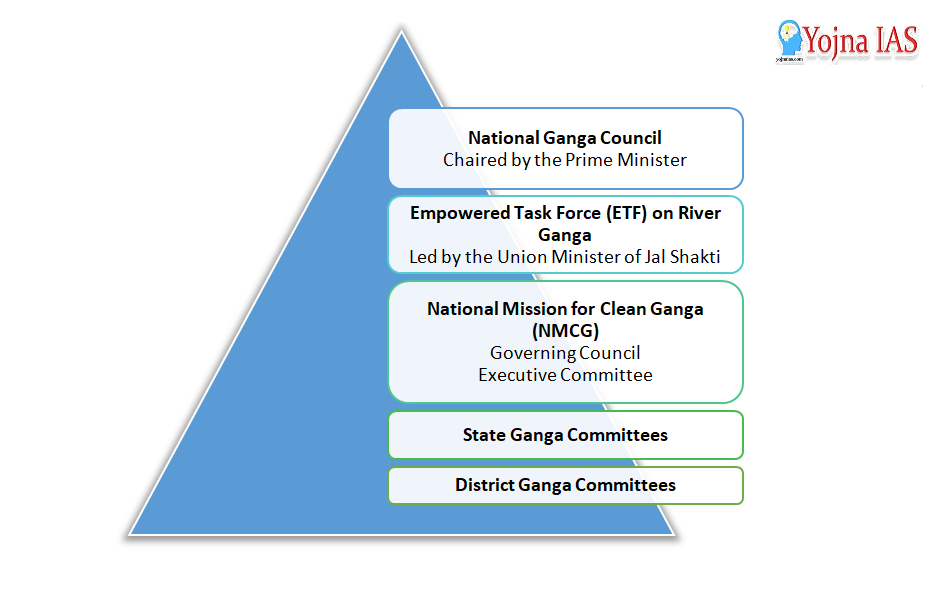04 Sep 2023 National Mission for Clean Ganga (NMCG)
This article covers “Daily Current Affairs” and the topic details “National Mission for Clean Ganga (NMCG)”. The topic “National Mission for Clean Ganga (NMCG)” has relevance in the “Ecology and Environment” section of the UPSC CSE exam.
For Prelims:
What is the National Mission for Clean Ganga (NMCG)?
Its Objectives and Institutional Framework?
For Mains:
GS3: Ecology and Environment
Why in the news?
Under the National Mission for Clean Ganga (NMCG), the Government has implemented treatment plants.
National Mission for Clean Ganga (NMCG)
- Formation: NMCG was officially registered as a society on August 12, 2011, in accordance with the Societies Registration Act 1860.
- Role as the Implementation Arm of NGRBA: Initially, NMCG functioned as the implementation body of the National Ganga River Basin Authority (NGRBA), which was established under the Environment (Protection) Act (EPA) of 1986.
- Dissolution of NGRBA and Emergence of National Ganga Council: In 2016, NGRBA was dissolved, coinciding with the creation of the National Council for Rejuvenation, Protection, and Management of River Ganga, known as the National Ganga Council.
- Aim and Purpose:
-
- The goal is to employ a river basin approach to effectively reduce pollution and revitalise the Ganga River.
- The objective is to uphold a minimum ecological flow in the Ganga River, striving for water quality and environmentally sustainable development.
- Five-Tier Structural Framework

- NMCG’s Two-Tier Structure: Under the Leadership of Director General, NMCG NMCG adopts a two-tier management structure comprising: Governing Council and Executive Committee.
- The Director General (DG) of NMCG holds the position of Additional Secretary in the Government of India, ensuring effective project implementation and coordination at the national and state levels.
- State Program Management Groups (SPMGs): Implementing Arm at State Level
- Parallel to the national structure, State Program Management Groups (SPMGs) serve as the implementing bodies for State Ganga Committees. These groups are headed by senior officers from the respective states.
- Holistic Approach to Ganga Cleaning and Rejuvenation
- This newly established structure aims to
- facilitate collaboration among all stakeholders involved in the mission,
- fostering a holistic approach to the cleaning and rejuvenation of the Ganga river.
- This newly established structure aims to
Significant Achievements in Ganga Cleaning
- Improved Water Quality: Water quality in the Ganga River now conforms to the “prescribed limits of notified primary bathing water quality.”
- Increase in Dolphin Population: The Ganga River has witnessed a remarkable increase in the population of dolphins, both adult and juvenile, rising from 2,000 to approximately 4,000. This indicates a healthier aquatic ecosystem.
- Resurgence of Indian Carp: The presence of Indian carp, a fish species known to thrive in clean water, has been reported more frequently by fishermen. This is a strong indicator of improved water quality.
- Development of Water Quality Index: The NMCG is actively working on developing a comprehensive water quality index, akin to the air quality index, to enhance communication about river-water quality. This initiative will facilitate better monitoring and understanding of Ganga’s water quality at various locations.
- Increase in Sewage Treatment Capacity: The mission has seen a substantial increase in sewage treatment capacity, with STPs capable of treating 2,665 MLD already commissioned and operational. In the last fiscal year (2022-23), 1,455 MLD of capacity was completed, marking significant progress in addressing sewage pollution.
Way Forward:
- Continue strict monitoring and enforcement of water quality standards.
- Expedite sewage treatment projects and identify areas needing treatment plants.
- Promote sustainable agricultural practices to reduce runoff.
- Conserve biodiversity and protect aquatic species.
- Engage local communities in awareness and cleanup efforts.
- Encourage research and innovation in river rejuvenation.
Sources: Seven years on, mission to clean the Ganga remains a work in progress – The Hindu
Yojna daily current affairs eng med 4th Sep 2023
Q1. With reference to National Mission for Clean Ganga (NMCG) , consider the following statements:
- The National Mission for Clean Ganga (NMCG) was constituted under the Water (Prevention and Control of Pollution) Act.
- NMCG works as the implementation arm of the National Ganga Council.
Which of the statements given above is/are correct?
(a) 1 only
(b) 2 only
(c) Both 1 and 2
(d) None
Answer: (b)
Q2. Consider the following statements:
- The National Ganga Council is chaired by the Prime Minister of India.
- The Empowered Task Force on River Ganga is headed by the Chief Ministers of Ganga River Basin on the basis of rotation.
- Director General of NMCG holds the position of Additional Secretary in the Government of India
How many of the abovementioned statements are correct ?
(a) Only one
(b) Only two
(c) All three
(d) None
Answer: (b)
Q3. What are the primary objectives and goals of NMCG in its mission to clean and revitalise the Ganga River? Analyse the significant achievements of NMCG in improving the water quality and ecological health of the Ganga River.


No Comments